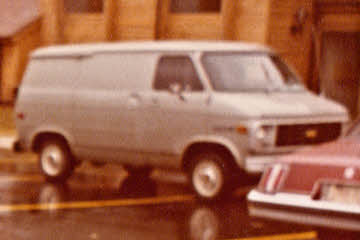 There are surely better pictures of this van around but this was all I could find as I wrote this post. It was my first new vehicle and one of only two that were custom ordered. A friend who worked at a dealer in Cincinnati handled the order. It had a 305 CI V8, 3-speed automatic, air-conditioning, cruise control, and no interior. By no interior I mean it had a basic driver’s seat and nothing else. I stopped on the way home from picking up the van and bought a pair of “captain’s chairs”. I sold the single stock seat back to the dealer for a few dollars.
There are surely better pictures of this van around but this was all I could find as I wrote this post. It was my first new vehicle and one of only two that were custom ordered. A friend who worked at a dealer in Cincinnati handled the order. It had a 305 CI V8, 3-speed automatic, air-conditioning, cruise control, and no interior. By no interior I mean it had a basic driver’s seat and nothing else. I stopped on the way home from picking up the van and bought a pair of “captain’s chairs”. I sold the single stock seat back to the dealer for a few dollars.
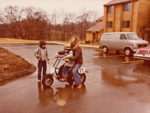 I clipped that opening shot from the photo at left. I’m helping my sons with a Christmas present so it must be late December which makes the van, delivered in September, just a few months old. The “conversion” may have started but I’m sure it had not progressed very far. Fletcher did eventually solo and so did Cris.
I clipped that opening shot from the photo at left. I’m helping my sons with a Christmas present so it must be late December which makes the van, delivered in September, just a few months old. The “conversion” may have started but I’m sure it had not progressed very far. Fletcher did eventually solo and so did Cris.
Calling what I did to the van a conversion stretches the definition of the word a bit. I covered the floor with plywood and the walls and ceiling with cheap paneling. That paneling went over scraps of insulation retrieved from a furnace manufacturer’s dumpster. Four inches of foam on a raised platform in the back served as a bed. I never did get around to carpeting the interior but that was probably for the best. Another thing I never got around to was seat-belts. The factory seat had a belt attached that went away with the seat. Mounting belts to the replacements was not recommended. What was supposed to be used were extra long belts bolted to the floor. That never happened.
This was a recreational vehicle. It made several camping trips to the Smokies and other nearby spots. It made one trip to Missouri and another to San Diego. In 1982 it attended the Knoxville World’s Fair.
At the time of the World’s Fair trip, all three kids were living with me full time. We were going on to visit friends in Alabama after our one day at the fair so the boys’ bicycles were hung on a rack on the front and the girl’s tricycle was stowed inside. The daughter and youngest son spent the night before in the van to avoid the need to wake up for the early morning departure. We had a great time at the fair although some of us got exhausted quicker than the others. Megan and I spent the last part of the day on a bench while the brothers ran around getting stamps on their fair passports. We were all exhausted by the time we reached a campground south of Knoxville. We were also pretty dirty from the hot day and looking forward to showers. That’s when we discovered we had no towels. Well, most of us had no towels. Only Fletcher had remembered this most important item (Douglas Adams would have been proud of him.) and after he had showered and dried the rest of us did the best we could with the no longer dry Star Trek beach towel.
In 1983 or ‘4 the van entered a new phase in its life. I attended my first of thirteen consecutive Indianapolis 500s in 1981. It was with a group who had several years experience camping at the track and charging into the infield on race morning. Parts of that charge resembled a demolition derby so most of the vehicles used were confirmed beaters. From its time as camper and all purpose transporter, the Chevy van had more than its ahare of dings and scratches but was not yet a beater when it was pressed into service as an Indy car. After a few years, I fully embraced the van’s participation in the annual event and built a deck on its top. Standing atop vehicles to watch the race was standard procedure and the deck made that easier and safer. The deck was made of something like 2x8s on edge and screwed to the gutters with plywood across the top.
I think it might have been the same year that the deck went on that the ignition went sour. A friend removed the ignition switch from the dash and ran new wire to it. It dangled from the dash and worked just fine. Track officials seemed to come up with a new rule or two every year and after several years with the sturdy deck in place, they decided it had to be removed. At that point there was only one person riding with me and, with screwdrivers and a hammer, the two of us ripped the deck off as quickly as we could.
The dangling ignition switch eventually gave out and I replaced it with two wall switches. One turned on the ignition and the other operated the starter. It was a pretty good anti-theft device although the possibility of any one stealing the van at this point was awfully slim. A blown freeze plug interrupted our last drive together. I nursed it home where it sat until a trade opportunity came along.
My Previous Wheels: Chapter 20 — 1972 Audi 100 LS
My Next Wheels: Chapter 22 — 1970 Chevelle

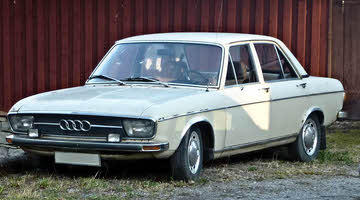 My friends had a red one that really impressed me. They were antique dealers and the car had been part of an exchange involving furniture. “If another deal like that ever comes along”, I told them, “I’ll take it.” It did and I did.
My friends had a red one that really impressed me. They were antique dealers and the car had been part of an exchange involving furniture. “If another deal like that ever comes along”, I told them, “I’ll take it.” It did and I did.
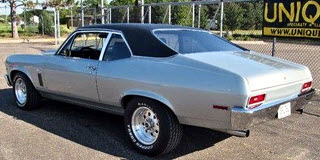 Again I must confess to a purloined photo gracing yet another My Wheels post. My car did not have the highly visible dual exhausts or fancy wheels of the pictured vehicle nor did it have the unseen 350 V8 and 4-speed floor shift. Mine was a 307 V8 with a 3-speed automatic. However, my car was, just like the one at right, a Cortez Silver 2-door with — and this is important — black vinyl top. It is the only vinyl topped car I’ve ever owned and one of very few I can even imagine owning without some level of embarrassment. While I doubt everyone agrees that the vinyl covering looks pretty good on this car it’s apparent that I’m not alone in thinking so. There are many full restorations of third generation Nova coupes that include a restored vinyl top. And that includes some high-end 396 Super Sports.
Again I must confess to a purloined photo gracing yet another My Wheels post. My car did not have the highly visible dual exhausts or fancy wheels of the pictured vehicle nor did it have the unseen 350 V8 and 4-speed floor shift. Mine was a 307 V8 with a 3-speed automatic. However, my car was, just like the one at right, a Cortez Silver 2-door with — and this is important — black vinyl top. It is the only vinyl topped car I’ve ever owned and one of very few I can even imagine owning without some level of embarrassment. While I doubt everyone agrees that the vinyl covering looks pretty good on this car it’s apparent that I’m not alone in thinking so. There are many full restorations of third generation Nova coupes that include a restored vinyl top. And that includes some high-end 396 Super Sports.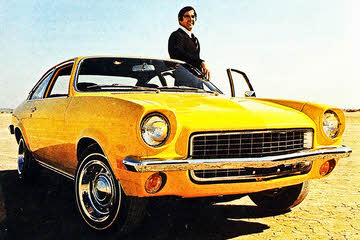 No. That’s not my Vega and that’s not me. It’s John DeLorean in the August 1970 issue of Motor Trend where he was singing the praises of Chevrolet’s new small car. The editors were singing right along with him and even adding some verses of their own. A month later, Car and Driver and Road & Track joined the choir. In February, Motor Trend named the Vega 2300 their 1971 “Car of the Year”. All this for a car that today has a reputation just slightly better than Yugo.
No. That’s not my Vega and that’s not me. It’s John DeLorean in the August 1970 issue of Motor Trend where he was singing the praises of Chevrolet’s new small car. The editors were singing right along with him and even adding some verses of their own. A month later, Car and Driver and Road & Track joined the choir. In February, Motor Trend named the Vega 2300 their 1971 “Car of the Year”. All this for a car that today has a reputation just slightly better than Yugo. I could’t find any pictures of the dark green 1971 Kammback that I bought in the summer of 1974 so I took to the internet. I didn’t have much better luck there. This black & white photo of what is identified as a 1972 model is the best I could do. The shortage of photos surprised me but so too did the abundance of early praise. I can’t explain the absence of decent Kammback photos so maybe my surprise at that is justified. My surprise at the praise isn’t. In fact, what those magazines said about the car — great handling, sporty looks, comfortable ride — is exactly what I thought of it forty years ago. I was surprised only because I had forgotten.
I could’t find any pictures of the dark green 1971 Kammback that I bought in the summer of 1974 so I took to the internet. I didn’t have much better luck there. This black & white photo of what is identified as a 1972 model is the best I could do. The shortage of photos surprised me but so too did the abundance of early praise. I can’t explain the absence of decent Kammback photos so maybe my surprise at that is justified. My surprise at the praise isn’t. In fact, what those magazines said about the car — great handling, sporty looks, comfortable ride — is exactly what I thought of it forty years ago. I was surprised only because I had forgotten.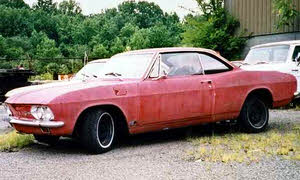 We had apparently become accustomed to being a two car family at this point so, when the blue Nova became a non-runner, I went shopping for another beater. I bought a 1965 Corvair in Kentucky. It didn’t look as ragged as the one at right (which might actually be a ’66) but it probably was. It was a full-on stripper with 3 on-the-floor, bare rubber floor mats, and no perceivable options other than an AM radio and even that might have been standard.
We had apparently become accustomed to being a two car family at this point so, when the blue Nova became a non-runner, I went shopping for another beater. I bought a 1965 Corvair in Kentucky. It didn’t look as ragged as the one at right (which might actually be a ’66) but it probably was. It was a full-on stripper with 3 on-the-floor, bare rubber floor mats, and no perceivable options other than an AM radio and even that might have been standard.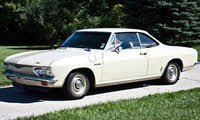
 It had begun life as a poor white Chevy and that was still the color of the top. The bottom had been painted fire engine red. It was a decent repaint and still pretty shiny. It was sort of a blend of these two cars minus the fancy wheel covers and all that chrome. It really didn’t look too bad from the proper distance. Up close, something of a reverse freckled look became noticeable. A few chips had appeared in the red part so that bits of the white part showed through. It was a mild case of reverse measles that gave the car “personality”. Yeah. That’s what it was. Personality.
It had begun life as a poor white Chevy and that was still the color of the top. The bottom had been painted fire engine red. It was a decent repaint and still pretty shiny. It was sort of a blend of these two cars minus the fancy wheel covers and all that chrome. It really didn’t look too bad from the proper distance. Up close, something of a reverse freckled look became noticeable. A few chips had appeared in the red part so that bits of the white part showed through. It was a mild case of reverse measles that gave the car “personality”. Yeah. That’s what it was. Personality.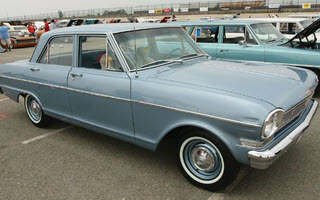 This car came and went while the Opel served as primary transport. I believe it was a 1962 model but it might have been a ’63. It was powered by a straight 6 mated to a two-speed Powerglide. It is the only car I’ve ever owned that I made money on.
This car came and went while the Opel served as primary transport. I believe it was a 1962 model but it might have been a ’63. It was powered by a straight 6 mated to a two-speed Powerglide. It is the only car I’ve ever owned that I made money on.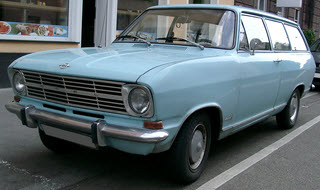 When it came time to replace the Dodge, we opted not for another American sedan but for a small import. However, since this was to be the family car, we made it a small import wagon, a 1969 Opel Kadett B Caravan. The family had, in fact, grown and there were now two young boys to fill the back seat. I don’t recall the purchase price but do remember that we bought the car from a couple professing to be witch and warlock and that the sickly Suzuki motorcycle was part of the deal.
When it came time to replace the Dodge, we opted not for another American sedan but for a small import. However, since this was to be the family car, we made it a small import wagon, a 1969 Opel Kadett B Caravan. The family had, in fact, grown and there were now two young boys to fill the back seat. I don’t recall the purchase price but do remember that we bought the car from a couple professing to be witch and warlock and that the sickly Suzuki motorcycle was part of the deal.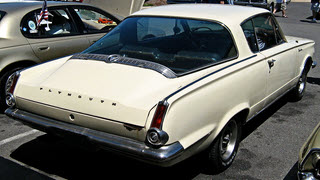 A white Plymouth Barracuda became mine after the
A white Plymouth Barracuda became mine after the 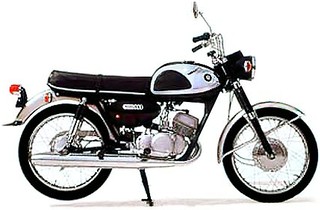 Dates from this period are a little fuzzy but I think it was not long after the Falcon Futura breathed its last that I acquired the Suzuki X-6 Hustler. A friend had bought it new then gave me a good deal on it when he went to New York to work his way to Europe as he had done once before. The working passage never quite came together and he returned after a few months and I offered to return the bike. He declined and I’m pretty sure part of the reason was pure kindness as he knew how much I was enjoying it.
Dates from this period are a little fuzzy but I think it was not long after the Falcon Futura breathed its last that I acquired the Suzuki X-6 Hustler. A friend had bought it new then gave me a good deal on it when he went to New York to work his way to Europe as he had done once before. The working passage never quite came together and he returned after a few months and I offered to return the bike. He declined and I’m pretty sure part of the reason was pure kindness as he knew how much I was enjoying it.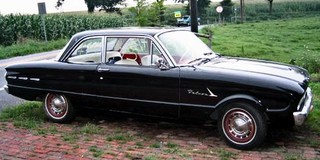 The 1961 in the title is something of a guess. I know for sure it was a first generation Falcon Futura. The first generation of Falcons ran from 1960 through 1963 with the bucket-seated Futura introduced in 1961. I believe mine was a ’61 but I guess it’s possible it was a year or two newer. If, however, you judged the car’s age purely on its condition, you would be challenged to believe it was a maximum of ten years old when I bought it in 1971 for $35.
The 1961 in the title is something of a guess. I know for sure it was a first generation Falcon Futura. The first generation of Falcons ran from 1960 through 1963 with the bucket-seated Futura introduced in 1961. I believe mine was a ’61 but I guess it’s possible it was a year or two newer. If, however, you judged the car’s age purely on its condition, you would be challenged to believe it was a maximum of ten years old when I bought it in 1971 for $35.